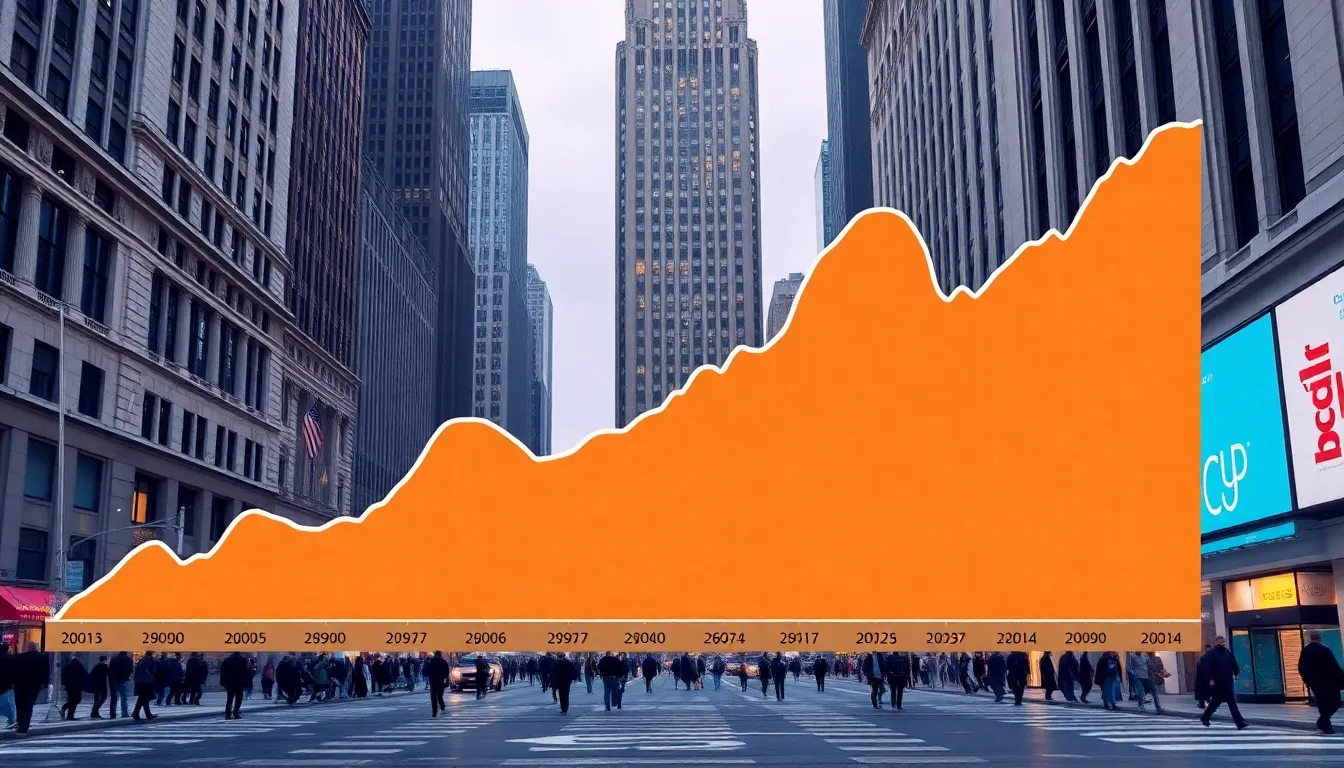Table of Contents
ToggleThe S&P 500 index is like that friend who always knows the hottest trends and keeps you on your toes. Whether it’s soaring to new heights or taking a nosedive, this index reflects the pulse of the American economy. Investors and analysts alike hang on its every move, trying to decipher what it means for their portfolios.
Overview of the S&P 500 Index
The S&P 500 index represents 500 of the largest publicly traded companies in the United States. Investors consider it a benchmark for measuring the performance of the U.S. stock market. Companies within diverse sectors, such as technology, healthcare, and financials, contribute to the index, creating a comprehensive view of market trends.
Volatility defines the S&P 500’s behavior, reflecting both upward and downward movements in stock prices. Significant market events can led to sharp fluctuations in the index. Analysts track these changes to assess market sentiment and predict economic trends.
Understanding the index’s current level helps investors make informed decisions. Regular updates reveal how the S&P 500 evolves in response to economic data, corporate earnings, or geopolitical developments. For example, a rising index level may signal economic growth, while a declining level often indicates market concerns or recession fears.
Investors also utilize the S&P 500 for portfolio allocation. Many choose to invest in index funds that replicate its performance, providing a diversified exposure to the stock market. Over time, the index has shown a historical upward trend, contributing to its appeal among long-term investors.
Monitoring the S&P 500 index remains crucial for anyone involved in the financial markets. Regularly checking its movements enables both novice and experienced investors to gauge market health and adjust strategies accordingly. The index serves as a vital indicator of economic vitality, guiding investment decisions.
Historical Performance of the S&P 500 Index

The S&P 500 index’s historical performance provides critical insights into market behavior over time. Analyzing its trends reveals how various events shaped the index.
Key Milestones
Significant milestones highlight the S&P 500’s long-term upward trajectory. In 1982, the index surpassed 100 points, setting a foundation for growth. By 2000, it reached a level of 1,500, showcasing the booming tech sector. After the dot-com bubble burst, the index dropped sharply but recovered to cross 1,000 in 2003. The financial crisis in 2008 saw it fall below 700 but rebounded to hit 4,000 by 2021. Each milestone reflects resilience and the index’s ability to adapt to changing economic landscapes.
Market Trends
Trends in the S&P 500 index illustrate shifts in market sentiment. Historically, bullish trends often follow economic recoveries, attracting more investors. In contrast, bearish trends align with recessions or major geopolitical events. Recent years showed volatility driven by factors like the COVID-19 pandemic and inflation concerns. Despite these fluctuations, the index generally demonstrates a tendency to regain lost ground over time. Current analysis suggests that understanding these trends aids investors in predicting future behavior.
Factors Influencing the Current Level
Several factors influence the S&P 500 index’s current level. Monitoring these components helps investors make informed decisions in a dynamic market.
Economic Indicators
Economic indicators play a crucial role in shaping the S&P 500. Metrics like GDP growth, unemployment rates, and inflation figures can significantly impact investor sentiment. A strong GDP growth rate often correlates with improved corporate profits, pushing the index higher. Conversely, rising inflation may lead to tighter monetary policies, affecting market performance. Tracking these indicators provides insights into the overall health of the economy and, consequently, the stock market.
Corporate Earnings Reports
Corporate earnings reports directly influence the S&P 500 level. Quarterly earnings announcements reveal how companies perform relative to analysts’ expectations. Positive earnings surprises often lead to stock price increases, lifting the index. Publicly traded companies within the S&P 500 represent diverse sectors, including technology, healthcare, and finance. As sectors report strong earnings, the index reflects that momentum, impacting overall market trends.
Geopolitical Events
Geopolitical events can create significant fluctuations in the S&P 500. Developments like trade negotiations, elections, or international conflicts affect market stability. Investor anxiety often rises during uncertain geopolitical times, leading to volatility in stock prices. Positive resolutions may bolster investor confidence, contributing to a rise in the index. Understanding these global dynamics helps investors gauge potential risks and rewards in the market.
Comparison with Other Indices
The S&P 500 index stands as a prominent barometer of the U.S. stock market, often compared with other major indices to gauge overall market health.
Dow Jones Industrial Average
The Dow Jones Industrial Average (DJIA) includes 30 large companies and serves as a key economic indicator. While the S&P 500 captures broader market sentiment through its 500 constituents, the DJIA focuses on industrial and blue-chip stocks, reflecting a different segment of the economy. Movements in the DJIA can indicate investor confidence, particularly in established companies. Recent levels in the DJIA show considerable correlation with the S&P 500, though the two indices may diverge in performance during periods of volatility.
NASDAQ Composite
The NASDAQ Composite index comprises over 3,000 stocks, heavily weighted towards technology. This index often showcases growth-oriented companies, making it distinct from the S&P 500’s diversified representation. Technology stocks tend to drive the NASDAQ, especially during innovation cycles. Fluctuations in NASDAQ can significantly impact investor sentiment in the tech sector, which occasionally leads to movements in the S&P 500. Current trends in NASDAQ highlight its propensity for sharper swings, reflecting investor enthusiasm or skepticism toward tech-driven market narratives.
Predictions for Future Levels
Analysts monitor various factors when predicting future S&P 500 levels. Economic growth remains a strong indicator, with GDP growth rates impacting investor sentiment. In times of strong growth, expectations for tighter monetary policy can elevate the index. Unemployment rates significantly drive market movements, as lower unemployment suggests economic strength that often positively influences the S&P 500.
Company performance also shapes future predictions. Positive earnings results from S&P 500 constituents typically lead to upward price adjustments. When major firms exceed expectations, they lift the overall index, making corporate earnings a vital consideration for projections. Analysts also pay attention to forward guidance from companies, which often signals future performance.
Geopolitical developments influence market behaviors as well. Heightened tensions can lead to increased volatility, potentially driving the S&P 500 lower. Conversely, resolutions of geopolitical issues tend to boost market confidence, providing upward momentum for the index.
Market sentiment is also influenced by industry trends, especially in technology and consumer services. High-profile tech stocks often drive momentum in the S&P 500 due to their substantial weight in the index. Following developments in these sectors can provide insights into future index movements.
Historical data underscores trends that help formulate predictions. Past performance during similar economic conditions often serves as a guide for future levels. Analysts frequently use this historical context to inform their expectations. Overall, evaluating these combined factors creates a clearer picture of potential future S&P 500 levels.
Monitoring the S&P 500 index is essential for investors seeking to navigate the complexities of the stock market. Its current level serves as a crucial indicator of economic health and investor sentiment. By keeping an eye on economic indicators and corporate earnings, investors can make informed decisions that align with their financial goals.
As the index continues to evolve with market trends and geopolitical developments, understanding its movements will remain vital. The S&P 500 not only reflects the performance of large U.S. companies but also shapes investment strategies across various sectors. Staying updated on its fluctuations can help investors capitalize on opportunities while managing risks effectively.




